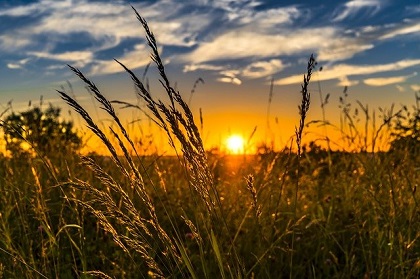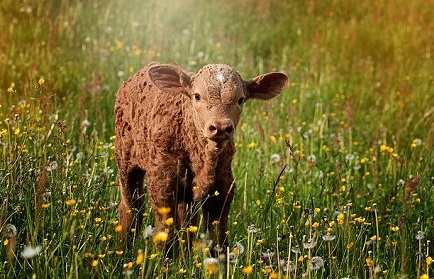Reflections
Thoughts · Daily PostA contemplation on World Wildlife Day
WHAT IF WE COULD GRANT THE GIFT OF FREEDOM TO EVERYONE?


This World Wildlife Day (3rd March 2022) Philip Lymbery, CEO Compassion in World Farming, shares his thoughts on bringing landscapes back and bursting with life the nature-friendly way:
'When you close your eyes and imagine where the very best food comes from, what does it look like?
In my experience, most people imagine rolling pastures sprinkled with cattle or sheep grazing under the warmth of the sun; orchards with chickens; patchworks of fields; golden swaying crops of corn, wheat or barley; the buzzing of bees. They think of diverse landscapes, the kind of place you'd love to visit, a view to admire.
What if we could Grant the Gift of Freedom to Everyone?
When you close your eyes and imagine where the very best food comes from, what does it look like?
In my experience, most people imagine rolling pastures sprinkled with cattle or sheep grazing under the warmth of the sun; orchards with chickens; patchworks of fields; golden swaying crops of corn, wheat or barley; the buzzing of bees. They think of diverse landscapes, the kind of place you'd love to visit, a view to admire. That sense of what feels right turns out to be ethical as well.
What I've discovered through my travels is that when we restore animals to the land in the right way - in well-managed, mixed rotational farms - amazing things can happen. Landscapes start coming back to life. There can be a cascade of positive benefits for farmers, consumers, the local environment, forests both near and far, and for animal welfare too.
Animal Health and Welfare
Free-ranging animals on pasture can run and jump and stretch their legs and wings. They can scratch and graze and peck and root. They can feel fresh air and sunshine, roll in grass, bathe in dust or wallow in cooling wet mud. They can express their nature, enjoy that freedom to behave normally something viewed as so important by the internationally recognised guidelines known as the 'Five Freedoms'.
And this gift of freedom matters so much to them. I can see just how much they appreciate it every time I let our hens out at home in the morning. I can see by the way they burst out of the coop with a flurry of excitement.
Is giving that gift of freedom to animals really too much to ask? Should it not be a basic right? After all, animals just want the space and scope to be themselves, and allowing them to do so brings more contented animals with better immunity and less disease.
It is also better for the environment and wildlife, the cause of celebration the world over this day (3rd March) every year: the United Nations World Wildlife Day. A day to draw attention to some of the most critically endangered species of wild fauna and flora, and to drive discussions towards implementing solutions to conserve them. Its theme 'Recovering key species for ecosystem restoration' reflects the fact that it has never been so important to address our biodiversity crisis, and 'nature' has a key role in the solution process. And keeping animals in genuinely welfare-friendly conditions has the huge additional benefit if done right of being nature-friendly too.
Restoring Soils
Giving animals freedom to roam means they can help soils regenerate too. The age-old nitrogen cycle of sunlight, soil, plants and the droppings of farm animals work together to return fertility to the soil. Cowpats from naturally healthy animals (without chemical treatments) become hives of life - harbouring numerous insects, like the dung beetles that thrive on taking parcels of poo underground.
Healthier soils encourage all sorts of creatures in a magical circle of life, from earthworms and oribatid mites to springtails and a whole host of tiny, microscopic creatures. Small they may be, but their contribution to our survival can be huge. They play key roles in maintaining fertility, structure, drainage and aerated soils, breaking down plant and animal tissues, releasing stored nutrients and converting them into forms that plants can use. Earthworms can multiply, perhaps the most important topsoil creatures, mixing soil and nutrients together, stirring up essential ingredients for healthy plant growth.
Healthy Eco-Systems
The landscape grows more varied, bursting with plants and flowers, luring back indispensable pollinating insects like bumblebees, along with hoverflies, butterflies, beetles and moths. This revitalised landscape provides patches of cover, homes for voles and other small creatures that also offer a living to barn owls and other predatory birds. Seeds and insects provide food for farmland birds to thrive once again, sustaining them through the harshness of winter and feeding hungry chicks during the summer.
Rearing animals on pastures rather than grain crops takes less water from rivers and aquifers for irrigation. Switching from grain-feeding, which is forty times more water intensive than grass, helps relieve some of the relentless demand on hard-pressed water courses.
Reducing the clamour for more farmland by cutting down on grain-fed farm animals, plus easing off on resource-intensive meat, can mean remaining forests are free to remain standing. Trees that might otherwise go the way of the chainsaw can carry on removing carbon from the atmosphere and returning oxygen for us to breathe
Food as Nature Intended
And wherever I go in the world, the one thing people consistently say about food from nature-friendly farming rather than industrial agriculture is that it tastes so much better, has so much more flavour.
In crossing continents, talking to the people behind our food, I've discovered that when animals are returned to the land in the right way, in well-managed mixed and rotational farms, whole landscapes spring to life.
Helping to revive a living countryside can be as easy as choosing to eat less and better meat, milk and eggs, making sure that any we do eat comes from animals afforded a decent life on farms that are pasture-fed, free-range or organic.
Nature gifts us many benefits: from the air we breathe, to the water we drink, and the food we eat; it enhances our wellbeing. On this UN World Wildlife Day, that seems something well worth celebrating.'
To read more blogs from Philip and find out about his work at Compassion in World Farming you can visit his website HERE